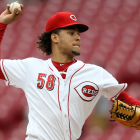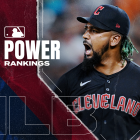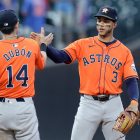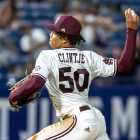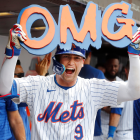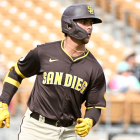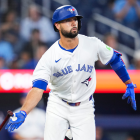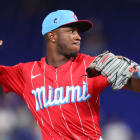How bad has the pitching in Cincinnati been over the years? The last time the Reds employed someone who made truly great pitches, it was Stalin's minister of propaganda.
In 2018, Reds pitchers finished second-to-last in the National League in park-adjusted ERA (so we can't just blame the homer-friendly confines of Great American Ballpark for the crooked numbers). The year before that, third-to-last. The year before that, second-to-last. This trend goes back a lot longer too. In the past 18 seasons, the Reds have finished in the bottom three in NL park-adjusted ERA seven times; they've finished in the top three just twice.
To be fair, there's a little bit of chicken-or-the-egg in play here. Teams with dim hopes of contending rarely invest significant resources in building a bullpen. You get what you pay for thus often manifests itself in some hideous reliever numbers. The Reds have made the playoffs just three times since 1996 (all three times happening in the four-year stretch of 2010 to 2013), so bloated reliever ERAs are to be expected.
- 2018 Result: 67-95, fifth place in NL Central
- Key free agents: None
- Needs: Starting pitching, outfield
But even if we set aside the struggles of those scrap-heap relievers, Cincinnati pitchers still carry an ugly track record over that near-quarter-century stretch. That's because, other than maybe the Orioles post-Mike Mussina, no team in this era has fared worse than the Reds at developing quality starting pitchers. As the Reds try to snap a streak of five straight losing seasons, plus that 23-year run of near-constant futility, that inability to identify and nurture elite starting pitching talent threatens to keep the bad times rolling for years to come.
It wasn't supposed to be this way. By now, the Reds were supposed to have a passel of talented, young pitchers, plying their trade in the majors and improving with every start. That's because the seeds of a pitching revolution looked like they might be sown three years ago.
At the end of the 2015 season, the Reds set an all-time record: They used a rookie starting pitcher every game for more than two months. Not every rookie pitcher who cracks a big-league rotation is destined for glory, of course. Anthony DeSclafani was the staff workhorse and de facto ace. DeSclafani was joined by John Lamb, a lefty who'd been named one of the top 20 prospects in the game by both Baseball America and Baseball Prospectus; Brandon Finnegan, not a homegrown Red but a talented southpaw who'd become the first pitcher ever to pitch in both the College World Series and MLB's World Series in the same year (the Reds got Finnegan and Lamb in a deal with the Royals for Johnny Cueto, the best homegrown Reds starter since the mid-90s and the Mussina-sized exception to the can't-develop-anyone-good rule); and Raisel Iglesias, a Cuban right-hander with electric stuff but also concerns over his durability and repertoire depth.
Iglesias has evolved into a dynamic young closer for the Reds ...which is sort of like having an Olympic-sized pool in the backyard of your rat-infested shack. After that, the Reds' grand pitching experiment of 2015 has proven to be fruitless. Just 29 of the 162 starts made by Reds pitchers in 2018 were by that cast of rookies from three years ago. Even if we expand this group to include the Reds' top three pitching prospects from 2015 who hadn't yet cracked the majors, the results don't look much better. Amir Garrett has gone from promising starter prospect to league-average relief pitcher, a role dozens of currently unsigned or easily available pitchers could also fill. As for Robert Stephenson and Cody Reed, we're still waiting for either of those once highly-touted wunderkinds to perform anything more than token spot start work in Cincinnati.
If the Reds want to follow their NL Central rivals in Chicago and Milwaukee to become a young, exciting contender, they're going to have to fill the massive holes that still remain in their rotation. If you're a Reds fan who's into shiny names, you'll be delighted to learn that they've been linked to everyone from two-time Cy Young winner Corey Kluber to Carlos Carrasco and James Paxton on the trade front to free-agent lefties Patrick Corbin, Dallas Keuchel, and J.A. Happ. Then you learn that the Reds' expected free-agent budget might not be enough to entice a front-line starter, and that raiding their farm system to get a number-one or number-two might be a long shot too.
It may well be prudent to wait rather than shoot the moon for arms, especially after a 97-loss season that saw the Reds looking up at the surging Brewers as well as other NL rebuilding teams like the Braves, Phillies and even the Padres, all of which are further down the road in their quest to build winning ballclubs. That means hoping and praying for some of the incumbents to break through.
Luis Castillo was supposed to be that guy in 2018. The Dominican right-hander was one of the hottest sleepers in the league coming into last season. His rookie campaign in 2017 saw huge strikeout and groundball numbers, and he finished eighth in NL Rookie of the Year voting despite hurling just 89 1/3 innings that year. But most of Castillo's numbers turned south in 2018, as his K rate, groundball rate, hit rate and home-run rate all stumbled in the wrong direction. Beyond Castillo, you've got a legion of forgettable pitchers, all of whom posted fielding-independent numbers last season that suggested ERAs around 5.00 or worse. Ugh.
There'll still be some good reasons to watch the Reds in 2019. You've got Eugenio Suarez mashing as one of the best and most underrated sluggers in the game. Joey Votto's numbers slipped last season, but he's still as close to a hitting savant as we've got. And young infielder Nick Senzel could climb into discussion for future batting titles the minute he stays healthy enough to make it to the Show, and stay there.
Just get ready for a lot more 8-5 games by the Ohio River in 2019. Until the Reds either get better at developing their own pitchers or more aggressive at finding them somewhere else, this is what Cincinnati home games will look like.
Jonah on the MLB offseason
NL East
Braves: May be offseason's most compelling team
Marlins: Finding where to send Realmuto
Mets: How Mets could jumpstart BVW era
Phillies: Harper or Machado might not be enough
Nationals: What will the Nats do if Harper leaves?
NL Central
Cubs: What the Cubs need to do to be World Series contenders in 2019









